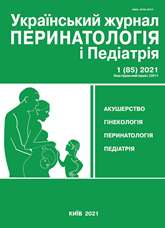The role of vitamin D3 deficiency correction in optimizing the treatment of anemia in women with autoimmune diseases
DOI:
https://doi.org/10.15574/PP.2021.85.7Keywords:
vitamin D deficiency, pregnant women, systemic lupus erythematosus, supplementationAbstract
The aim is to analyze the effectiveness of correction vitamin D deficiency in the treatment of anemia in women with systemic lupus erythematosus (SLE).
Materials and methods. Concomitant documented levels of 25-hydroxyvitamin D, hemoglobin, ferritin, and serum iron in a group of women with SLE who applied for preconception counseling were analyzed. All women were in remission for SLE activity within 5 to 6 months. A total of 54 women were involved in iron metabolism disorders (decreased ferritin, hemoglobin, serum iron). Vitamin D deficiency was detected at <30 ng/ml, and anemia at hemoglobin <120 g/l. Group 1 consisted of 32 women with vitamin D levels <30 ng/ml who received antianemic therapy with ferrous sulfate with ascorbic acid, correction of vitamin D deficiency with Olidetrim 2000 U (Polpharma), and group 2 — women with vitamin D levels <30 ng/ml (n=22) who received antianemic therapy with ferrous sulfate with ascorbic acid and a vitamin complex containing vitamin D 400 U. The groups were comparable by the main demographic indicators (age, education, socio-economic level). In both groups, iron metabolism and 25-hydroxyvitamin D levels were monitored in 4 weeks after treatment.
Results and conclusions. Women with SLE have a high risk of chronic inflammatory anemia development, which can be combined with iron deficiency anemia. To improve the results of treatment, it is proposed to introduce supplementation with a high dose of vitamin D (Olidetrim 2000 U), into complex therapy which contributes to the effectiveness of correction of deficiency of this vitamin, as well as the onset of long-term recovery of iron store, hemoglobin concentration.
The study was conducted in accordance with the principles of the Declaration of Helsinki. The research protocol was approved by the Local Ethics Committee of the institution mentioned in the work. Informed consent of women was obtained for the research.
The authors declare no conflict of interest.
References
Bacchetta J, Chun RF, Gales B et al. (2014). Antibacterial responses by peritoneal macrophages are enhanced following vitamin D supplementation. PLoS One. 9: e116530. https://doi.org/10.1371/journal.pone.0116530; PMid:25549329 PMCid:PMC4280222
Jin HJ, Lee JH, Kim MK. (2013). The prevalence of vitamin D deficiency in iron-deficient and normal children under the age of 24 months. Blood Res. 48: 40-45. https://doi.org/10.5045/br.2013.48.1.40; PMid:23589794 PMCid:PMC3624995
Nairz M, Haschka D, Demetz E, Weiss G. (2014). Iron at the interface of immunity and infection. Front Pharmacol. 5: 152. https://doi.org/10.3389/fphar.2014.00152; PMid:25076907 PMCid:PMC4100575
Nemeth E, Ganz T. (2014). Anemia of inflammation. Hematol Oncol Clin North Am. 28: 671-681. https://doi.org/10.1016/j.hoc.2014.04.005; PMid:25064707 PMCid:PMC4115203
Shin JY, Shim JY. (2013). Low vitamin D levels increase anemia risk in Korean women. Clin Chim Acta. 421: 177-180. https://doi.org/10.1016/j.cca.2013.02.025; PMid:23466602
Sim JJ, Lac PT, Liu IL et al. (2010). Vitamin D deficiency and anemia: a cross-sectional study. Ann Hematol. 89: 447-452. https://doi.org/10.1007/s00277-009-0850-3; PMid:19841921 PMCid:PMC2840674
Zittermann A. (2006). Vitamin D and disease prevention with special reference to cardiovascular disease. Prog Biophys Mol Biol. 92: 39-48. https://doi.org/10.1016/j.pbiomolbio.2006.02.001; PMid:16600341
Zughaier SM, Alvarez JA, Sloan JH et al. (2014). The role of vitamin D in regulating the iron-hepcidin-ferroportin axis in monocytes. J Clin Transl Endocrinol. 1: 19-25. https://doi.org/10.1016/j.jcte.2014.01.003; PMid:25097830 PMCid:PMC4119757
Downloads
Published
Issue
Section
License
The policy of the Journal “Ukrainian Journal of Perinatology and Pediatrics” is compatible with the vast majority of funders' of open access and self-archiving policies. The journal provides immediate open access route being convinced that everyone – not only scientists - can benefit from research results, and publishes articles exclusively under open access distribution, with a Creative Commons Attribution-Noncommercial 4.0 international license(СС BY-NC).
Authors transfer the copyright to the Journal “MODERN PEDIATRICS. UKRAINE” when the manuscript is accepted for publication. Authors declare that this manuscript has not been published nor is under simultaneous consideration for publication elsewhere. After publication, the articles become freely available on-line to the public.
Readers have the right to use, distribute, and reproduce articles in any medium, provided the articles and the journal are properly cited.
The use of published materials for commercial purposes is strongly prohibited.

